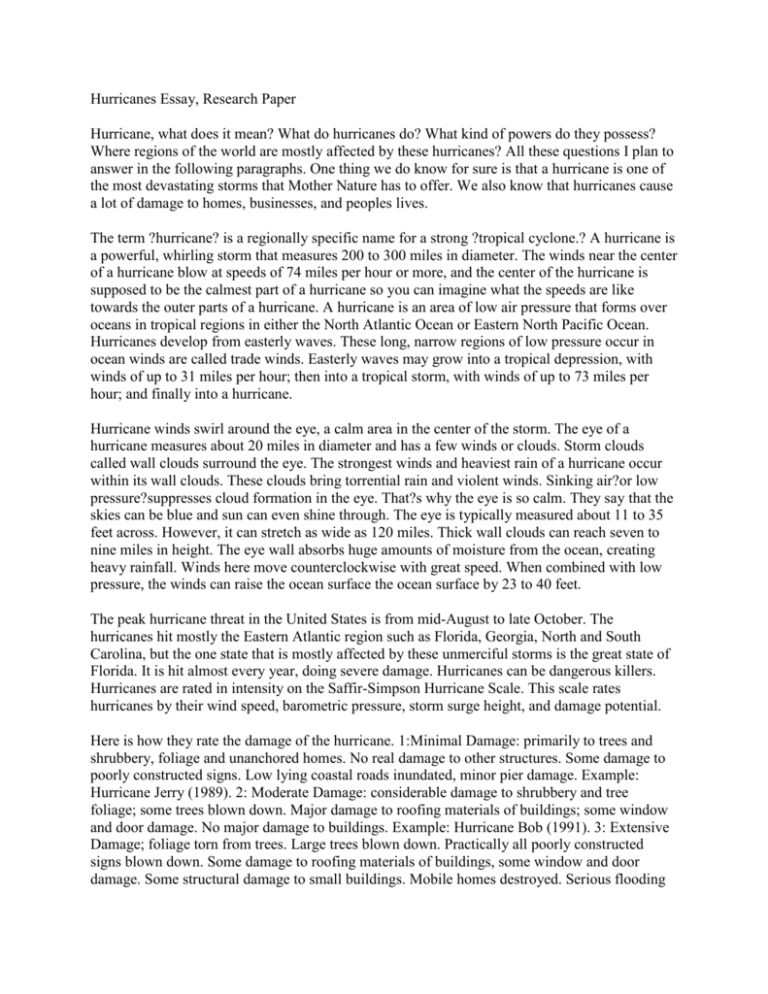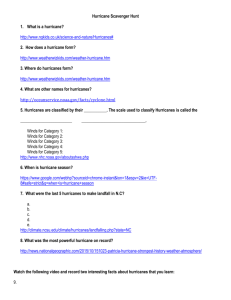скачати - Essays, term papers, dissertation, diplomas
advertisement

Hurricanes Essay, Research Paper Hurricane, what does it mean? What do hurricanes do? What kind of powers do they possess? Where regions of the world are mostly affected by these hurricanes? All these questions I plan to answer in the following paragraphs. One thing we do know for sure is that a hurricane is one of the most devastating storms that Mother Nature has to offer. We also know that hurricanes cause a lot of damage to homes, businesses, and peoples lives. The term ?hurricane? is a regionally specific name for a strong ?tropical cyclone.? A hurricane is a powerful, whirling storm that measures 200 to 300 miles in diameter. The winds near the center of a hurricane blow at speeds of 74 miles per hour or more, and the center of the hurricane is supposed to be the calmest part of a hurricane so you can imagine what the speeds are like towards the outer parts of a hurricane. A hurricane is an area of low air pressure that forms over oceans in tropical regions in either the North Atlantic Ocean or Eastern North Pacific Ocean. Hurricanes develop from easterly waves. These long, narrow regions of low pressure occur in ocean winds are called trade winds. Easterly waves may grow into a tropical depression, with winds of up to 31 miles per hour; then into a tropical storm, with winds of up to 73 miles per hour; and finally into a hurricane. Hurricane winds swirl around the eye, a calm area in the center of the storm. The eye of a hurricane measures about 20 miles in diameter and has a few winds or clouds. Storm clouds called wall clouds surround the eye. The strongest winds and heaviest rain of a hurricane occur within its wall clouds. These clouds bring torrential rain and violent winds. Sinking air?or low pressure?suppresses cloud formation in the eye. That?s why the eye is so calm. They say that the skies can be blue and sun can even shine through. The eye is typically measured about 11 to 35 feet across. However, it can stretch as wide as 120 miles. Thick wall clouds can reach seven to nine miles in height. The eye wall absorbs huge amounts of moisture from the ocean, creating heavy rainfall. Winds here move counterclockwise with great speed. When combined with low pressure, the winds can raise the ocean surface the ocean surface by 23 to 40 feet. The peak hurricane threat in the United States is from mid-August to late October. The hurricanes hit mostly the Eastern Atlantic region such as Florida, Georgia, North and South Carolina, but the one state that is mostly affected by these unmerciful storms is the great state of Florida. It is hit almost every year, doing severe damage. Hurricanes can be dangerous killers. Hurricanes are rated in intensity on the Saffir-Simpson Hurricane Scale. This scale rates hurricanes by their wind speed, barometric pressure, storm surge height, and damage potential. Here is how they rate the damage of the hurricane. 1:Minimal Damage: primarily to trees and shrubbery, foliage and unanchored homes. No real damage to other structures. Some damage to poorly constructed signs. Low lying coastal roads inundated, minor pier damage. Example: Hurricane Jerry (1989). 2: Moderate Damage: considerable damage to shrubbery and tree foliage; some trees blown down. Major damage to roofing materials of buildings; some window and door damage. No major damage to buildings. Example: Hurricane Bob (1991). 3: Extensive Damage; foliage torn from trees. Large trees blown down. Practically all poorly constructed signs blown down. Some damage to roofing materials of buildings, some window and door damage. Some structural damage to small buildings. Mobile homes destroyed. Serious flooding at coast and many smaller structures near the coast are destroyed. Battering waves and floating debris damages larger structures on the coast. Example: Hurricane Gloria (1985). 4: Extreme Damage: Shrubs and trees blown down, all signs are blown down. Extensive damage is done to roofing materials, windows and doors. Complete destruction to mobile homes. Massive evacuations of all residents within 500 yards or shore possibly required, and single story residents within two miles of the shore. Example: Hurricane Andrew (1992). 5: Catastrophic: Shrubs and trees blown; considerable damage to roofs of buildings; all sings are blown down. Very severe and extensive damage to windows and doors. Complete shattering of windows. Some complete failures in buildings. Small buildings are overturned or blown away by the high winds. Major damage to lower floors of all structures than 15 feet above sea level within 500 yards of the shore. Massive evacuation of all residents on low ground within 5-10 miles of shore is possibly required. Example: Hurricane Camille (1965). Most hurricanes move westward at first and become larger and stronger as they travel. Then they turn from the equator and pick u p speed. Most hurricanes turn east after they reach temperate latitudes, where they are called extra-tropical storms. Many end as weak storm centers over cool oceans. The United States is not the only part of the world that has hurricanes. Over in the Far East they experience some of the worst such as Japan, Korea, and China. Some of these hurricanes have destroyed some of the world?s greatest tourist sites in the Far East. All the above paragraphs show why the hurricane is one of the most dangerous, deadly and feared storms to ever happen. Bibliography Work Cited Physical Science Fourth Edition, Bill W. Tillery www.mhhe.com/tillery www.naturaldisasters.com http://ua-referat.com





